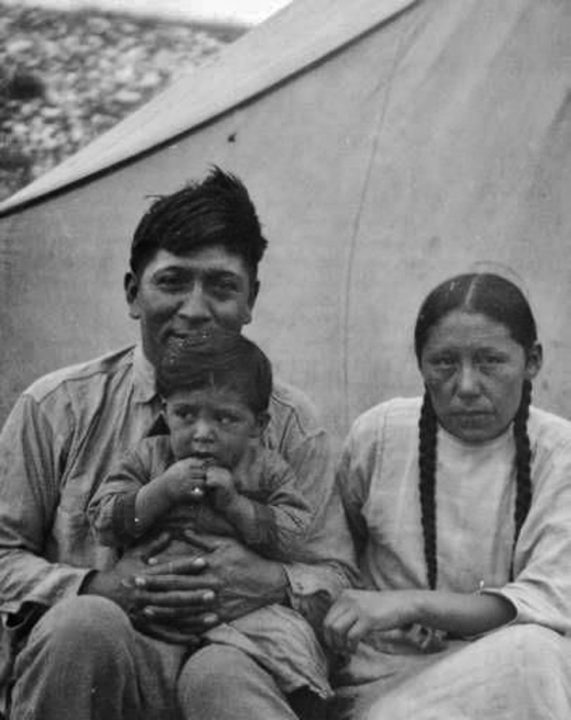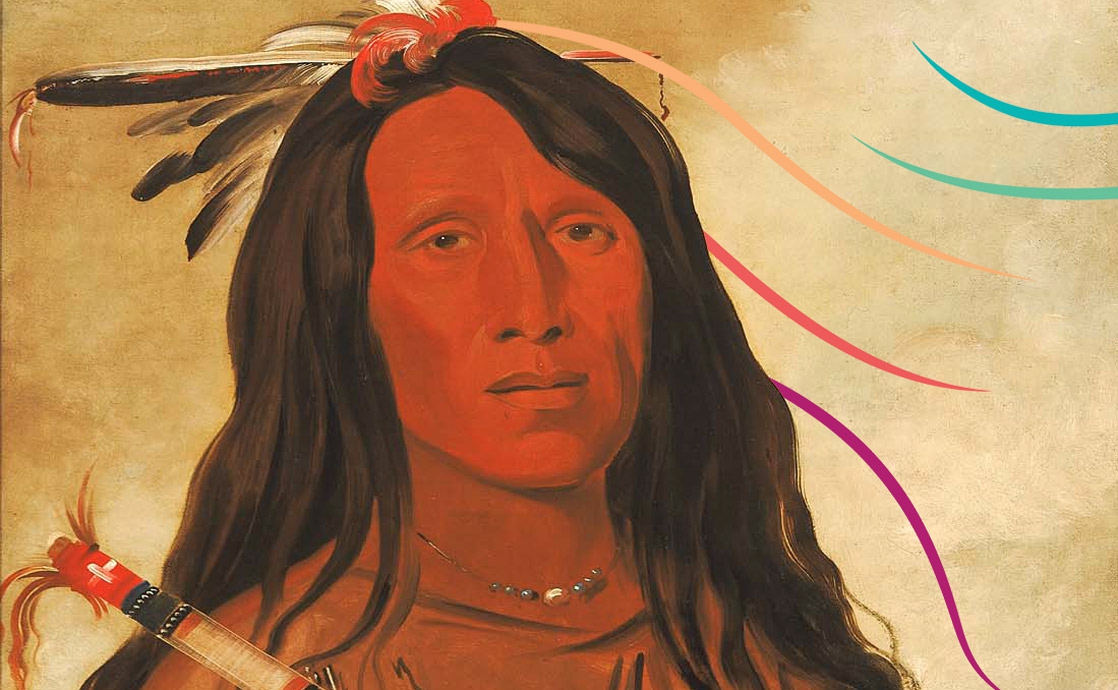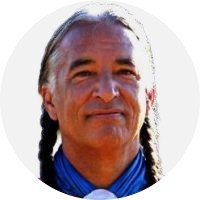The views expressed in our content reflect individual perspectives and do not represent the authoritative views of the Baha'i Faith.
In this installment of Chris Buck’s and Kevin Locke’s continuing series on Indigenous messengers of God, we focus on the Cheyenne prophet Sweet Medicine – and his remarkably Baha’i-like spiritual path.
Q: Kevin, to my surprise and delight, Vinson Brown, in his informative and ground-breaking book Voices of Earth and Sky, wrote about his memorable meeting with John Stands-in-Timber (1882–1967), the Cheyenne tribal historian. Stands-in-Timber’s Yale University Press book Cheyenne Memories records the legacy and sacred teachings of Sweet Medicine, which we introduced in Part 30 of this series, “Sweet Medicine: Cheyenne Messenger of God.” Vinson Brown wrote:
Yet even in the sadness of their long sleep there is something about the Cheyenne people that makes me feel very close to them in spirit. They are still a warm and impulsive people, open-faced and open-hearted. My first meeting with them was in the summer of 1965 when I took my family and the twelve-year-old son of some friends on a trip to visit many tribes. At Lame Deer, Montana, on the Northern Cheyenne Reservation, I saw a group of Cheyenne men seated under the shade of some trees talking, two of them being young men, the other four much older. When I waved to them they waved back and, on impulse, I took over to them a gift copy of the book on which I had collaborated with an Eskimo (William Willoya) called Warriors of the Rainbow—Strange and Prophetic Dreams of the Indian Peoples.
Of the group, three whose names I remember were Charley White Dirt, an older man who spoke little English; Francis Black Horse, a young man, and John Stands-in-Timber. The latter, who was tall and straight like his name, had a face I shall always remember for its strong and honest look, but the rest were all fine-looking men, too. John was in his eighties at the time, but seemed quite healthy and could speak good English. He is dead now, but the author of a fine book on his people, called Cheyenne Memories, the results of his being the historian of his tribe.
It was John Stands-in-Timber who thumbed through my book as I sat silently with the group, stopping here and there to translate some of it into Cheyenne. After a bit, Charley White Dirt spoke to him in Cheyenne, and John translated, saying, to my pleased surprise: “We all feel this book has a good and strong spirit. We are happy you have given it to us.”
We camped that night on the reservation, but the next morning I went looking for the group again and found John Stands-in-Timber and Charley White Dirt standing near the same place as before, but with two new men. John said to me: “Charley wants to say something to you very important.”
Charley White Dirt let loose at me a string of Cheyenne that I could not understand except that I realized he was speaking with the utmost earnestness. Then John translated for him:
“He says that soon he and three or four others of our people are going to Bear Butte, our Sacred Mountain, the place where Sweet Medicine had his great vision. They are going to seek visions and they want you to go with them and also help pray for the peace of the world!”
I was thrilled to the depths of my being by these words, as I realized these men had accepted me in their spiritual adventure because of the words written in Warriors of the Rainbow, but immediately I was overwhelmed by the greatest sadness, for I realized I had other commitments that I could not get out of.
When regretfully I declined, but saying I would hope to try again another year, I then asked John Stands-in-Timber who Sweet Medicine was.
“He is the Sacred One who brought us our religion,” he said, “and told us what would happen to us. He is the Great One who came to our people long ago.”
From John, then from other sources later, I learned the strange and wonderful story about Sweet Medicine, which I give here in shortened form. – Voices of Earth and Sky.
On p. vi of Cheyenne Memories, the following statement expresses John Stands-in-Timber’s view of the significance of this publication:
“John Stands In Timber died on June 17, 1967, as this book—the work he cherished most of all in a long lifetime—was in press. Those of us who have worked with him over a decade to make it a reality have been saddened beyond measure that he will never hold it in his hands.“
The statement that Cheyenne Memories is the work that John Stands-in-Timber “cherished most of all in a long lifetime” indicates that the contents of this book – including his information on Sweet Medicine – was intended for the public in a good and meaningful way.
Do you agree, Kevin, that since Cheyenne tribal historian John Stands-in-Timber gave these sacred Indigenous traditions and teachings to the public, that we have offered our Indigenous Messengers of God series in the same spirit of respect, reverence and service?

A: Absolutely! In my heart of hearts, I feel certain that you and I have been moved by the messages brought to humanity by the primal and original Indigenous teachers of this land, to give voice to the long hidden and ignored spiritual heritage of this half of the planet.
Through the inspiration of these Wise Ones who have appeared to the various tribes in the Americas — the voices of the Great Spirit – we have been inspired to create this wider awareness and appreciation, much the same way John Stands-in-Timber did, in his efforts to preserve and promote the priceless legacy of Sweet Medicine in the Cheyenne tradition.
All Indigenous peoples have sacred protocols regarding our duty to acknowledge, with profound gratitude and respect, the originally Indigenous land into which we may venture, live and prosper – in order that we may seek the blessings of these voices of the Great Spirit, whose legacies we have acknowledged throughout this series of essays.
In essence, the reality of the sacred teachings of all these Indigenous messengers is the recognition of our relatedness, by and through our connection with God, the Great Spirit. These teachings were imparted by the Wise Ones, who gave voice to the Call of God throughout these lands that we now call the Americas.
By honoring and acknowledging those Wise Ones who have imparted their sacred Indigenous teachings, we thereby honor God. This acknowledgment is proof that those of us who do so are civilized and enriched by having received and respected the Indigenous spiritual heritage of the Americas.
Q: Kevin, would you also say that the sacred teachings of Sweet Medicine resonate vibrantly with Baha’i teachings, which represent a kind of spiritual echo, amplification and universalization of this authentic Indigenous voice and vision?
A: One of the proofs of the ascendancy of Sweet Medicine’s living legacy and influence is the strength and vibrancy with which it has endured in the hearts of the Cheyenne, despite near physical annihilation at the hands of the US government.
I agree that Sweet Medicine’s sacred teachings echo and resonate, in perfect harmony, with the essence of the Baha’i teachings. If, in the spiritual realms, Sweet Medicine and Baha’u’llah were ever to meet, I feel they would immediately recognize each other as voices of the Great Spirit, and would embrace each other as fellow Chiefs, in their sacred brotherhood as great spiritual teachers. I believe they would have no problem at all in instantly recognizing and respecting each other’s mission and vision.
Q: Kevin, how can the Cheyenne and Baha’i sacred traditions interconnect and interrelate with each other, intensify and enrich each others’ worldviews in the process?
A: Deep in the heart of the Black Hills country, the sacred mountain, known as “Bear Butte,” is also known as “Mato Paha” or “Bear Mountain” among the Lakota people, in my homeland of South Dakota.
According to Cheyenne tradition, Bear Butte is where the holy man Sweet Medicine met the Great Spirit and the Four Sacred Beings who guard the universe. They taught Sweet Medicine about the Four Sacred Arrows — of which two were for hunting and two for war. Many ceremonies were connected with these Four Sacred Arrows, which stood for many laws, and for a good government as well.
In my favorite telling of the vision of Sweet Medicine, as he passed through the portal into the Divine Presence at Bear Butte, the Chief of all the holy souls – who Baha’is know as Baha’u’llah – bade him to be seated at his right side.
There, for four days, Sweet Medicine received the heavenly commandments that would prepare the Cheyenne people for the day when that Chief himself would later appear. In my opinion, that Chief is Baha’u’llah, who would later teach us all how to bring about spiritual brotherhood throughout this great planet, just as he wrote in The Tabernacle of Unity:
The children of men are all brothers, and the prerequisites of brotherhood are manifold. Among them is that one should wish for one’s brother that which one wisheth for oneself. Therefore, it behoveth him who is the recipient of an inward or outward gift or who partaketh of the bread of heaven to inform and invite his friends with the utmost love and kindness.

















Comments
Sign in or create an account
Continue with Googleor